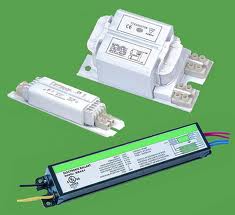Ballasts are devices required for the operation of gas lamps (including fluorescent lamps, metal halide lamps, and high pressure sodium lamps). Ballasts provide the initial starting voltage to a gas lamp. The initial starting voltage provided by the ballasts creates an electrical arc that excites the gases in the lamp, thus producing light. In the cases of pre-heat and rapid start circuits, ballasts heat the electrodes in the lamp allowing for arc discharge. After the ballasts provide the initial starting voltage the ballasts regulate voltage at an optimal level for lamp operation. Ballasts compensate for voltage fluctuations during lamp operation.

Magnetic Ballasts
Magnetic ballasts are older devices that use a magnetic transformer made of a steel core and copper windings, along with a simple bi-metal switch for thermal protection and a simple capacitor. They are larger and heavier than electric ballasts.
Electronic Ballasts
Electronic ballasts use circuits to control the flow of current. These use a magnetic output transformer, an EMI filter, a rectifier and integrated circuitry to manage the flow of current very precisely. These ballasts are smaller and lighter than magnetic versions.
Dimming ballasts are available in both magnetic and electronic versions, but there are distinct advantages to using electronic dimming ballasts. To dim lamps, magnetic dimming ballasts require control gear containing expensive high power switching devices that condition the input power delivered to the ballasts. This is economically viable only when controlling large numbers of ballasts on the same branch circuit. In addition, luminaires must be controlled in large zones that are determined by the layout of the electrical distribution system. Since the distribution system is fixed early in the design process, control systems using magnetic dimming ballasts are inflexible and are unable to accommodate changes in usage patterns.
Magnetic ballasts do well with traditional, long-tube fluorescent lights used for everyday applications. However, fluorescent lights that dim, or compact fluorescent lights, often require electric ballasts. Magnetic ballasts simply do not have the capability to control current in specific ways necessary to dim a bulb or provide power to multiple bulbs at one time. The more complicated the application, the better the electric ballast will be.
Metal Halide Ballasts | High Pressure Sodium Ballasts | Fluorescent ballasts | Gear Tray
Links: Porcelain lamp socket | Mercury Vapor Ballast | Light bulb socket
Xml Copyright: @2012-2020 James Lighting Electronic Co.,Ltd